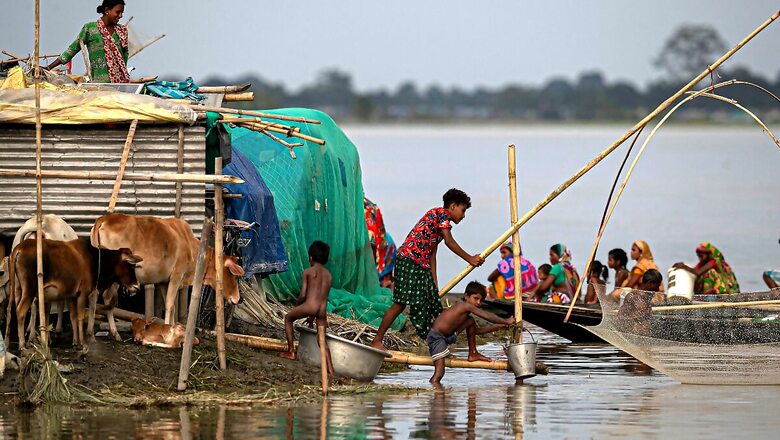
views
The southwest monsoon is set to retreat from parts of north India in the next two days, the India Meteorological Department (IMD) said on Sunday, even as fresh floods hit Assam affecting 2.25 lakh people in nine districts. Incessant rains in the last few days has triggered this year's third wave of floods in the state, claiming one life in Nagaon district on Saturday, said the Assam State Disaster Management (ASDMA).
The fresh fatality has pushed the number of deaths in flood-related incidents in Assam this year to 118, it added. Delhi recorded a maximum temperature of 36.2 degrees Celsius, which is two notches above the normal, while the minimum temperature was 23.2 degrees Celsius.
The national capital's air quality improved marginally on Sunday due to high wind speed, while favourable ventilation conditions are likely to keep it in the "moderate" category for the next three days, a government forecasting agency said. The city registered a 24-hour average air quality index (AQI) of 117 on Sunday, an improvement from 165 on Saturday. An AQI between 0 and 50 is considered 'good', 51 and 100 'satisfactory', 101 and 200 'moderate', 201 and 300 'poor', 301 and 400 'very poor', and 401 and 500 'severe'.
Sporadic farm fires were observed on Saturday around Punjab and border regions but its impact has been negligible so far due to unfavourable wind direction and speed, the System of Air Quality and Weather Forecasting and Research (SAFAR) said. However, it said that late withdrawal of monsoon and associated stagnant winds are likely to influence Delhi's air quality negatively by the weekend.
In neighbouring Uttar Pradesh, light rains and thundershowers occurred at isolated places, with the meteorological department predicting mostly dry weather in the state on September 28 and September 29. The maximum and minimum temperatures in Punjab and Haryana hovered around 35 degrees Celsius and 21 degrees Celsius respectively, with parts of both the states witnessing overcast conditions.
In the northeastern state of Assam, the districts of Dhemaji, Lakhimpur, Morigaon, Nagaon, Majuli, West Karbi Anglong, Sivasagar, Dibrugarh and Tinsukia have been affected, the ASDMA said in its report. Nagaon is the worst-hit district with 1.51 lakh people affected, followed by Morigaon (32,711), Dhemaji (16,792) and Dibrugarh (10,622), it said, adding over 10,000 hectares of crops have been submerged.
The mighty Brahmaputra river is flowing above the danger mark at Neamatighat in Jorhat district and Tezpur in Sonitpur. Road connectivity has been affected in Morigaon, Nagaon and West Karbi Anglong districts while 43 relief camps have been set up in three districts so far, the ASDMA said.
Meanwhile, the weather department said, "Conditions are becoming favourable for withdrawal of monsoon from west Rajasthan and adjoining areas from September 28." Data suggests the country has received 9 per cent more rainfall than normal until September 26 and the rainy season is most likely to end on an above-normal note. Mahesh Palawat, the vice president of private forecaster Skymet Weather, said, "The withdrawal of monsoon from west Rajasthan is likely to start from tomorrow (Monday). It looks like monsoon will withdraw on an above-normal note." Rainfall in the range of 96 to 104 per cent of the Long Period Average (LPA) is considered as 'normal', while precipitation in the range of 104 to 110 per cent of the LPA is 'excess'.
Nine states have received excess rainfall, while 20 states have recorded normal precipitation, the data shows. The official rainfall season in India is from June 1 to September 30. Monsoon arrived over Kerala on June 1, its normal onset date.
June recorded 17 per cent more rainfall, while July saw 10 per cent deficiency. However, there was an excess rainfall in August — the month recorded 27 per cent more rainfall than normal. Parts of north India — Delhi, Himachal Pradesh, Jammu and Kashmir — have recorded deficient rainfall. The Union Territory of Ladakh has recorded high deficiency of rainfall this year.
Large parts of the country in the west and south India, including Gujarat, Goa, Telangana, Andhra Pradesh, Tamil Nadu and Karnataka, have received excess rainfall. Sikkim is the only state to have received large excess rainfall. Rain and thundershower were observed in at most places in Andhra Pradesh, coastal and north Karnataka in the south, and some northeastern states of Assam, Meghalaya, Tripura as well as sub-Himalayan West Bengal. Parts of Bihar, Jharkhand and Tamil Nadu received rains.
Most of Telangana also received rains with Dandepalle in Mancherial district recording 11 cms of precipitation followed by six cms in Sarangapurnrl in Nirmal district and five cms in Sangareddy. Heavy rains had lashed several parts of the state on Saturday resulting in massive flooding and waterlogging in low-lying areas.



















Comments
0 comment